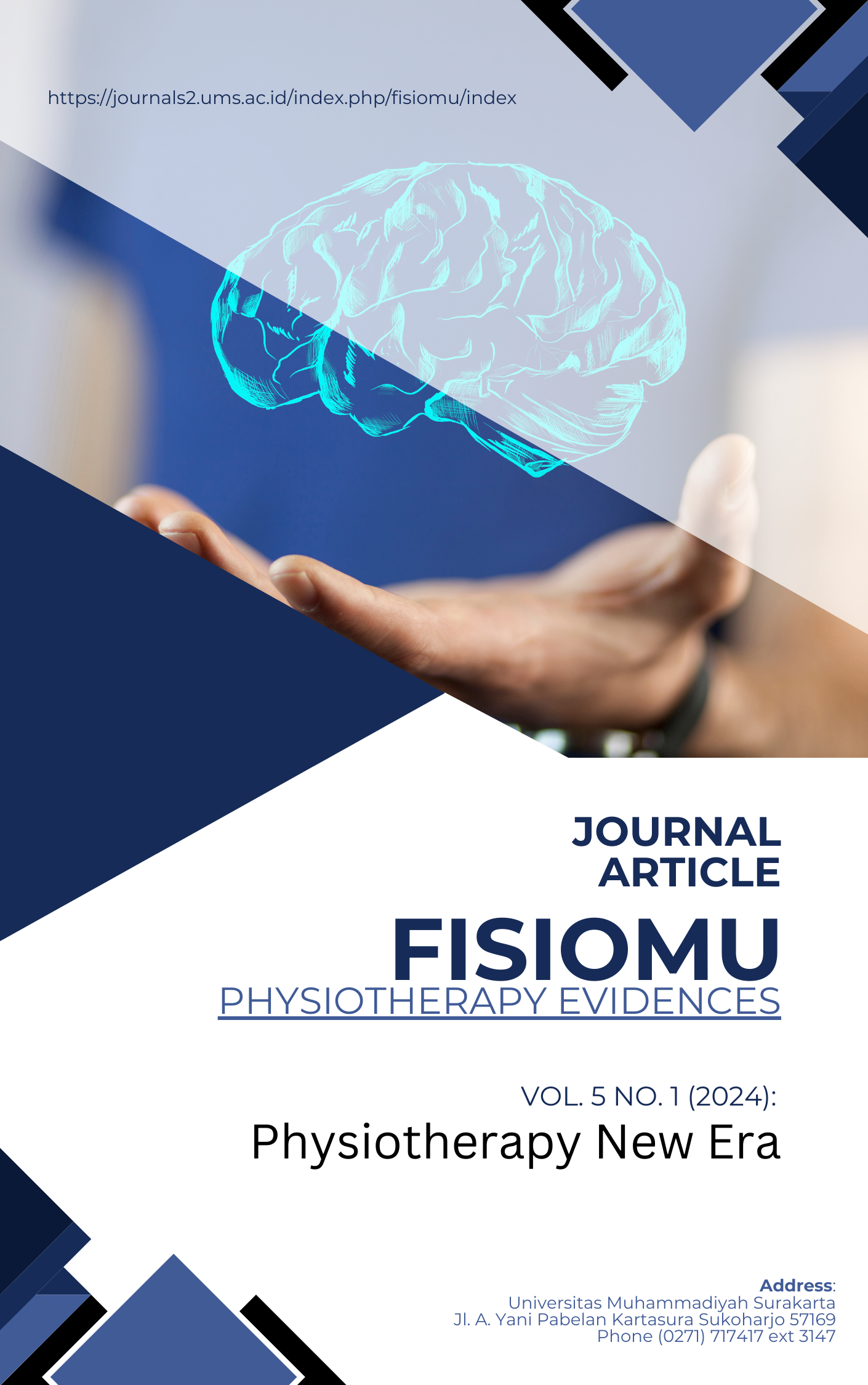Differences in the Effectiveness of Dynamic Stretching Exercise and Static Stretching Exercise on Lumbar Flexibility for Elderly
DOI:
https://doi.org/10.23917/fisiomu.v5i1.3000Keywords:
Fisioterapi, physiotherapyAbstract
Introduction: Muscle flexibility begins to decline around 20% - 30% at the age of 30-70 years old. Decreased flexibility of the lumbar muscles will result in various problems. The condition will continue to worsen if stretching is not done. The study is to investigate the difference in effectiveness difference of dynamic stretching exercise and static stretching exercise on lumbal flexibilities in the elderly. Methods: The study was experimental with pre and post-test two-group design. The data were taken by using a random sampling technique. The samples were 32 people aged 60 – 79 years old. Results: The result of data analysis using a Paired Sample t-test in groups I and II showed p=0.000 (p<0.05) meaning that there was no significant difference in improving lumbal flexibilities in the elderly. Conclusion: Static and dynamic stretching both enhance flexibility, but static stretching is more effective for flexibility improvement, while dynamic stretching better enhances muscle power and performance quality.
Downloads
References
Analisis Statistik BPS. (2022). Statistik Penduduk Lanjut Usia 2022. Badan Pusat Statistik Provinsi D.I. Yogyakarta.
Arfadilah, N. (2022). Hubungan Aktivitas Fisik Dengan Tingkat Fleksibilitas Punggung Pada Lansia Di Lembaga.
Ayu Vitalistyawati, L. P., Weta, I. W., Munawaroh, M., Ngurah, I. B., Griadhi, I. P. A., & Imron, M. A. (2018). Pilates Exercise Lebih Efektif Meningkatkan Fleksibilitas Lumbal Dibandingkan Senam Yoga Pada Wanita Dewasa. Sport and Fitness Journal, 6(2), 23–30.
Behm, D. G. (2018). The Science and Physiology of Flexibility and Stretching. In The Science and Physiology of Flexibility and Stretching (Issue November 2018).
https://doi.org/10.4324/9781315110745
Inswiarsi., Laksono, D. T., Sumarno, S., Ary, S., & Gandaputra, S. A. (2013). Lansia Terhadap Fleksibilitas Lumbal Di Panti Werdha Pstw Usada Mulia Dan Yayasan Panti Jompo Pusaka 41. Jurnal Ilmiah Fisioterapi Volume, 3, 41–47.
Kemenkes RI. (2018). Hasil Riset Kesehatan Dasar Tahun 2018. Kementrian Kesehatan RI, 53(9), 1689–1699.
Kurniawan, E. Y., Kesoema, T. A., & Hendrianingtyas, M. (2019). Pengaruh latihan fleksi dan ekstensi lumbal terhadap fleksibilitas lumbal pada dewasa muda. Jurnal Kedokteran Diponegoro, 8(1), 161–170.
Medeiros, D. M., Cini, A., Sbruzzi, G., & Lima, C. S. (2016). Influence of static stretching on hamstring flexibility in healthy young adults: Systematic review and meta-analysis. Physiotherapy Theory and Practice, 32(6), 438–445.
Miftahul, reski. (2020). Pengaruh Core Stability Exercise terhadap Fleksibilitas Punggung Bawah pada Remaja Overweight di SMK Negeri 2 Malang. Kaos GL Dergisi, 8(75), 147–154.
Mistry, G., Vyas, N., & Sheth, M. (2014). Correlation of hamstrings flexibility with age and gender in subjects having chronic low back pain. International Journal of Therapies and Rehabilitation Research, 3(4), 31. https://doi.org/10.5455/ijtrr.00000040
Mujtahidin, A. N., Fatmaningrum, W., & Kinandita, H. (2015). Hubungan Antara Indeks Massa Tubuh (Imt) Dengan Fleksibilitas Lumbal Pada Mahasiswa Fakultas Kedokteran. JUXTA: Jurnal Ilmiah Mahasiswa Kedokteran Universitas Airlangga, 7(1), 32–36.
Ningsih, R. (2018). Efektifitas Stretching Di Sela Pelatihan Terhadap Intensitas Fatigue Pada Peserta Pelatihan Balai Latihan Kerja. Jurnal Media Kesehatan, 8(2), 113–120. https://doi.org/10.33088/jmk.v8i2.267
Nitaya Putri Nur Hidayati, R. N. (2019). Perbedaan Pengaruh Static Stretching Dan Dynamic Stretching Terhadap Peningkatan Fleksibilitas Pada Otot Hamstring.
Novikasari, N. (2013). Pengaruh pemberian static stretching terhadap peningkatan fleksibilitaslumbal pada lanjut usia di desa guli kabupaten boyolali. 1–13.
Putri, M. E. N., Dewi, A. A. N. T. N., Tianing, N. W., & Winaya, I. M. N. (2020). Hubungan Fleksibilitas Lumbal Dengan Keseimbangan Dinamis Pada Lansia Yang Mengikuti Senam Lansia Di Desa Sumerta Kelod Denpasar Timur. Majalah Ilmiah Fisioterapi Indonesia, 8(3), 46. https://doi.org/10.24843/mifi.2020.v08.i03.p04
Ratna Ningrum, T. S. (2018). Perbedaan pengaruh latihan active stretching,hold relax, dan contract relax terhadap peningkatan fleksibilitas togokpada adolescent ditinjau dari jenis kelamin. JHeS (Journal of Health Studies), 2(2), 93–99. https://doi.org/10.31101/jhes.474
Rejeki, P. S., Rahim, A. F., & Prasetya, R. E. (2018). Effect of Physical Training Towards Body Balance in Overweight Condition. Biomolecular and Health Science Journal, 1(2), 141.
Ribeiro, M. F., Patrizzi, L. J., Teixeira, V. de P. A., & Espindula, A. P. (2016). Equilibrium and muscle flexibility in elderly people subjected to physiotherapeutic intervention. Acta Scientiarum - Health Sciences, 38(2), 129–136. https://doi.org/10.4025/actascihealthsci.v38i2.28836
Shaharuddin, S. bt S., & Mondam, S. (2017). The Effectiveness of Static and Dynamic Stretching on Hamstring Flexibility after 4-Weeks Training to Prevent the Risk of Injuries. Malaysian Journal of Medical and Biological Research, 4(1), 7–14. https://doi.org/10.18034/mjmbr.v4i1.417
Waluyo, I., Inswiasri, Adhi, W. P., & Arsyad, N. (2013). Perbedaan Kemampuan Fleksibilitas Sit and Reach Test Berdasarkan Usia, Jenis Kelamin, Penyakit Sendi Dan Rasio Lingkar Pinggang Panggul (Rlpp) Pada Usia 15 – 59 Tahun Di Kelurahan Duren Sawit Jakarta Timur Tahun 2012. Jurnal Ilmiah Fisioterapi, 3 (Edisi A.
Downloads
Submitted
Accepted
Published
How to Cite
Issue
Section
License
Copyright (c) 2023 Fisio Mu : Physiotherapy Evidaces Journal

This work is licensed under a Creative Commons Attribution-NonCommercial-NoDerivatives 4.0 International License.

This work is licensed under a Creative Commons Attribution-NonCommercial 4.0 International License.
Authors who publish with FISIO MU: Phsiotherapy Evidences agree to the following terms:
- Author(s) retain copyright and grant the journal right of first publication with the work simultaneously licensed under a Creative Commons Attribution-NonCommercial 4.0 International License that allow others to share the work within an acknowledgement of the work’s authorship and initial publication of this journal.
- Author(s) are able to enter into separate, additional contractual arrangement for the non-exclusive distribution of the the journal’s published version of the work (e.g. acknowledgement of its initial publication in this journal).
- Author(s) are permitted and encouraged to post their work online (e.g. in institutional repositories or on their websites) prior to and during the submission process, as it can lead to productive exchanges, as well as earlier and greater citation of published works.












